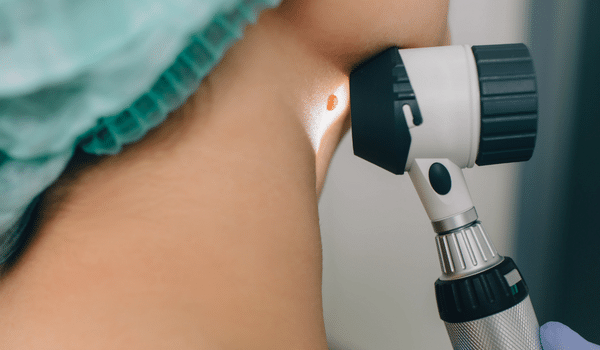Before we dive into the mole removal process, let’s start with some basics. Moles are a common skin lesion that can sometimes lead to needing a mole removal procedure. Moles form when skin cells grow in a cluster. They can be slightly raised or completely flat. While typically black or brown in color, they can darken throughout your lifetime due to sun exposure or pregnancy.
Types of Moles
There are four types of moles. Congenital moles, moles that you are born with, are very common, and occur in one in 100 people. While congenital moles can be small or large, the larger your congenital mole, the higher risk you are at for melanoma. Dysplastic nevi are moles that are considered abnormal. These moles are usually larger in size, have an uneven surface, and have uneven edges. Dysplastic nevi commonly turn into melanoma.
Acquired nevi are moles that appear after you are born. This is not unusual and does not mean they are cancerous. Unfortunately, if you have 50 or more moles, then you may be at a higher risk for melanoma. Spitz nevi are the fourth type of moles. A biopsy is often needed to distinguish spitz nevi from melanoma. Spitz nevi may bleed or leak pus, which would require the care of a dermatologist.
Seborrheic keratosis is often mistaken for melanoma. Understanding the differences in seborrheic keratosis vs melanoma can not only help your anxiety but can also aid in receiving the appropriate treatment by your dermatologist. While seborrheic keratosis can look like a pre-cancerous skin growth or skin cancer, it is harmless. They often appear as you age. They can sometimes become inflamed or irritated, but otherwise pose no risk to your health.
Who Do You See for Mole Removal?
Your dermatologist will check your moles and perform a mole removal and other dermatologic surgeries if necessary. Keeping an eye on your moles can help you identify when it’s time to discuss a mole removal with your dermatologist.
ABCDE’s of Moles
Knowing the ABCDEs of moles allows you to accurately assess your moles at home. When completing a self-screening you should be on the lookout for Asymmetry, jagged Borders, darker Colored moles, moles large in Diameter, and moles that are Evolving. Scheduling an annual in-office skin screening will keep an eye on those hard-to-reach areas you may miss when completing a self-screening.
During your in-office screening, your dermatologist will look for any abnormal moles. If a mole looks concerning, a biopsy will be performed. This will determine if the mole is benign, pre-cancerous, or cancerous. If the biopsy identifies the mole as pre-cancerous or cancerous, a mole removal procedure will be performed.
How Does Mole Removal Work?
Before the mole removal process is started, you are given a numbing injection near the mole. While the injection may cause a little pain, this will numb the area for the duration of the mole removal process. Following the numbing of the mole and surrounding area, one of three techniques will be used for the mole removal.
- Shave biopsy – Your dermatologist will use a blade to shave off the mole and the surrounding skin.
- Punch biopsy – A tool is placed over the mole and “punches” the mole out.
- Scalpel removal – Your dermatologist will use a scalpel to remove the mole and the surrounding skin. This technique requires stitches to help the skin heal properly.
Once the mole removal is completed, the sample is sent to the lab for analysis. Within two weeks, your dermatologists will have the results. If the analysis shows normal, healthy cells, no further treatment is needed. If the skin cells show pre-cancerous or cancerous cells, your dermatologist will determine next steps and if any further treatment is needed.
Will Mole Removal Leave a Scar?
While mole removal procedures are low risk, the procedure may leave a scar. Scarring may disappear over time depending on the size of the scar, your age, and the mole placement. In general, your wound will take two to three weeks to heal.
Some methods to reduce scarring can be started once the wound has fully healed, but it is essential to care for your wound properly during the healing process to have the best chances of reducing the appearance of scars. Other ways to reduce the appearance of your scar include avoiding the sun while the wound is healing, trying not to stretch the area while it’s healing, and keeping the wound clean and moist.
If you’re unsure if your moles or scars may be cancerous, schedule an appointment with your dermatologist to conduct a skin cancer screening. Vujevich Dermatology Associates is a trusted dermatology office that offers mole removal from some of the most highly trained physicians and clinicians in the greater Pittsburgh area. You can reach our team at 412-429-2570 or visit our contact page to see all of our locations. You can also follow us on Facebook to see what’s new in the world of dermatology.

